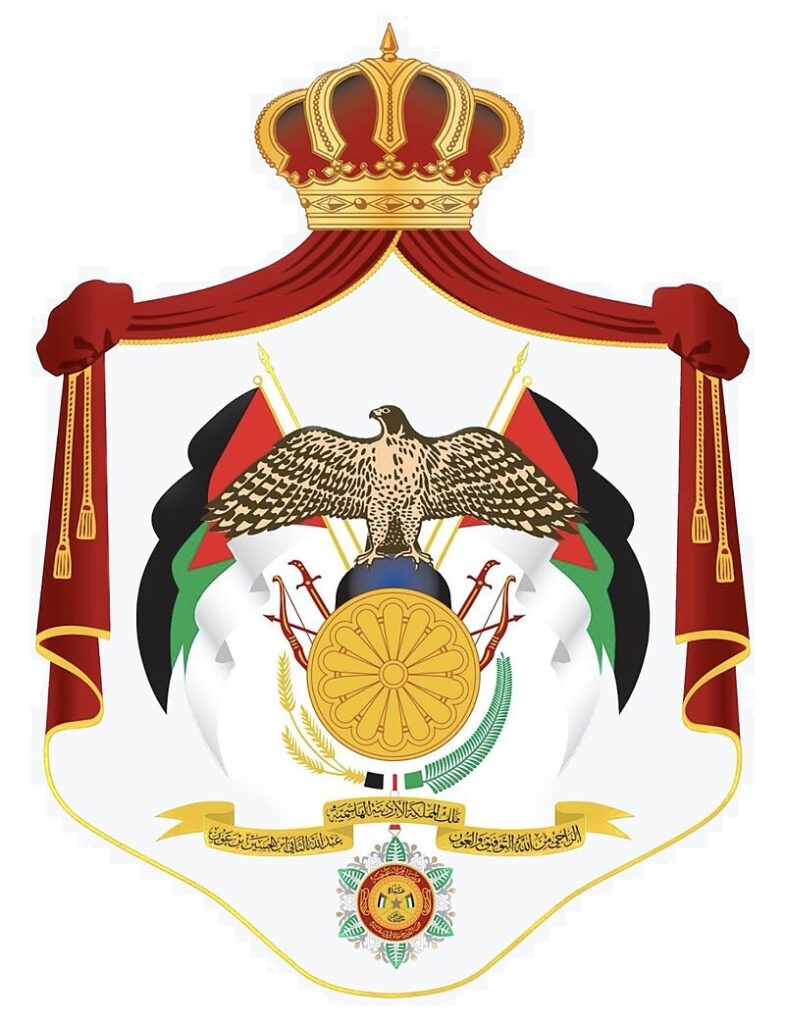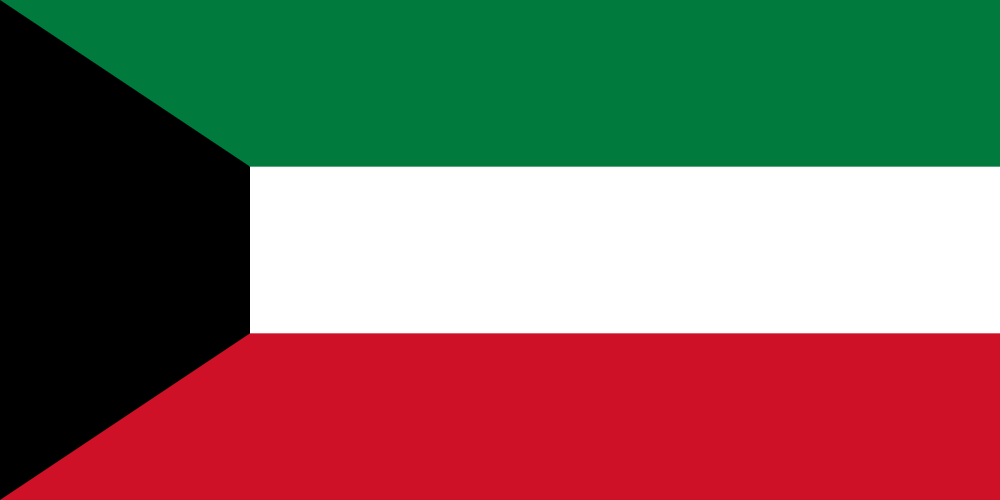The flag of Jordan, established in 1928, symbolizes the nation’s resilience and distinctiveness. It captures the essence of Jordanian values and cultural ethos. Serving as more than a national emblem, this flag reflects its people’s collective aspirations and enduring character, marking Jordan’s unique place in the world.
Flag of Jordan

The flag of Jordan is distinguished by its striking design, featuring three horizontal stripes and a red chevron at the hoist side. Within the chevron lies a seven-pointed star, a symbol deeply rooted in the nation’s heritage.
This aesthetic design represents Jordan’s historical and cultural narrative, embodying the nation’s distinct legacy and role in regional events. The flag’s layout and symbols collectively capture the essence of Jordan’s identity on the global stage.
Flag of Jordan: Color Palette

Jordan Flag Emoji: 🇯🇴
The color palette of Jordan’s flag is both vibrant and symbolic, featuring a harmonious blend of black, white, green, and red. These colors are visually striking and carry deep-seated meanings that resonate with Jordan’s historical and cultural narratives.
Meaning of Each Color

Black
The black band on Jordan’s flag represents the Abbasid dynasty. The Abbasids, a prominent dynasty of the Islamic Caliphate, were known for their intellectual achievements and contributions to Islamic culture, notably in Baghdad, their capital. This color on the flag is a tribute to its historical significance and impact on Islamic civilization.
White
The white band symbolizes the Umayyad dynasty. Renowned for expanding the Islamic empire and establishing Arabic as the empire’s official language, the Umayyads played a crucial role in shaping early Islamic history. The white color reflects a period of growth and expansion.
Green
The green band stands for the Fatimid or Rashidun Caliphates. The Rashidun Caliphate is often revered for its adherence to the teachings and practices of the Prophet Muhammad, considered a golden age of Islam by many.
The Fatimid dynasty, known for founding Cairo, represents a significant era in Islamic history. Green is a color deeply associated with Islam and symbolizes growth and vitality.
Red Chevron
This symbolizes the Hashemite dynasty and the Arab Revolt. The Hashemite dynasty, originating from the lineage of the Prophet Muhammad, has played a pivotal role in the modern history of the Arab world.
The Arab Revolt, marked red, signifies the struggle for Arab independence and unity against the Ottoman Empire during World War I.
Jordan’s Coat of Arms

Jordan’s Coat of Arms, a symbol of its monarchy and national identity, was originally designed in 1921 and formally adopted in 1934.
The emblem continued to be used after Jordan became an independent kingdom in 1946 and was officially renamed the Hashemite Kingdom of Jordan in 1949.
The Coat of Arms is a visual narrative of Jordan’s royal and cultural heritage:
- Royal Hashemite Crown: Symbolizes the monarchy, with a design of five arches and a spear tip, representing the Hashemite banner.
- Crimson Velvet Sash: Underneath the crown, this sash represents the Royal Hashemite Throne, embodying sacrifice and purity.
- Eagle: Depicting power and grit, the eagle on the Coat of Arms stands on a blue globe, indicating the rise of Islamic civilization.
- Bronze Shield: A shield with a chrysanthemum design signifies the defense of truth and justice.
- Weapons: Various traditional Arab weapons around the shield and globe symbolize strength and defense.
- Wheat and Palm Branch: These elements represent fertility and victory below the shield.
- Medal of Al Nahda First Order: This prestigious medal, adorned with inscriptions, hangs from the center of the ribbon.
This Coat of Arms not only represents the royal lineage of Jordan but also reflects the country’s rich cultural heritage and its values of strength, purity, and the defense of rights.
Historical Evolution and the Meaning Behind Changes
The flag of Jordan has evolved, reflecting the nation’s history and changing political landscape. Originally, the region used the Ottoman flag, signifying its incorporation into the Ottoman Empire.
During the Arab Revolt against Ottoman rule, a new flag was introduced, featuring the now-familiar Pan-Arab colors in horizontal stripes with a red triangle, symbolizing Arab unity and the Hashemite dynasty’s role in the revolt.

With the establishment of the Emirate of Transjordan under British rule, the flag was slightly modified, maintaining the design inspired by the Arab Revolt but adding a seven-pointed star. This addition imbued the flag with further symbolic significance.
The modern Jordanian flag, adopted in 1928, closely resembles its predecessor from the Arab Revolt era but is distinguished by the specific configuration of the seven-pointed star in the red chevron.
The flag’s evolution mirrors Jordan’s transition from Ottoman rule to British mandate and ultimately to an independent nation, each change capturing a significant era in Jordan’s national narrative.
Overall Symbolic Meaning of the Flag

The flag of Jordan symbolizes the nation’s historical depth, culture, and united national identity. It reflects the country’s journey from ancient times to its present sovereignty, intertwining religious and historical significance and serving as a reminder of Jordan’s unique story and the collective spirit of its people.
Similar Flags to the Flag of Jordan
Jordan’s flag is distinct from several other countries’ flags, reflecting their intertwined histories and cultural heritage within the Arab world. Let’s explore these similar flags and understand the connections.
Kuwait

Kuwait’s connection to Jordan’s flag is not only historical but also symbolic of the broader Arab solidarity in the region. Their flags represent a common identity and unity among Arab nations, echoing their mutual aspirations and collective heritage.
Sudan

The resemblance between Sudan’s and Jordan’s flags also reflects the Arab nationalism that swept through the region in the 20th century. Both countries embraced these colors to symbolize their part in the wider Arab world and their shared historical experiences.
United Arab Emirates

The UAE’s flag shares similarities with Jordan’s as a testament to the enduring influence of Pan-Arabism across the Gulf and Levant regions. The common elements in their flags underscore a shared vision and cultural identity among the Arab states.
Final Thoughts
The flag of Jordan, embodying a rich historical narrative and cultural significance, serves as a unifying symbol for its people and a distinct emblem in the international community of flags. It reflects Jordan’s heritage and its citizens’ national pride and identity.
Image Sources and Copyright Information
- Jordanian Flag Over Amman Skyline: © leshiy985/Shutterstock
- Pin on Jordan Location Map: © GR.Stocks/Shutterstock
- Flag of Sudan: © Mini Onion/Shutterstock